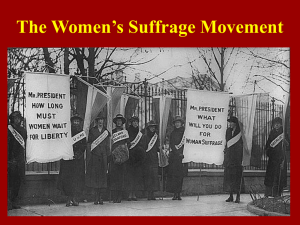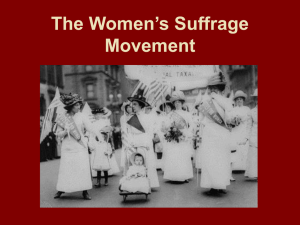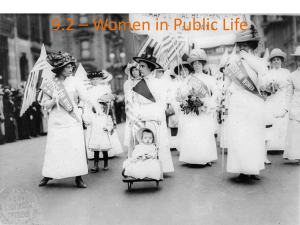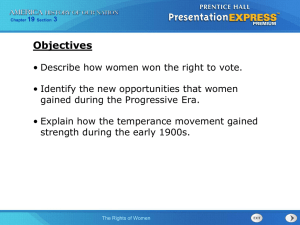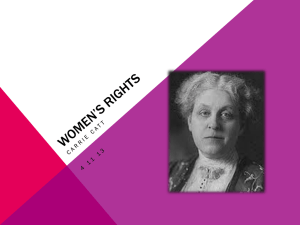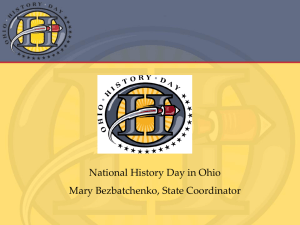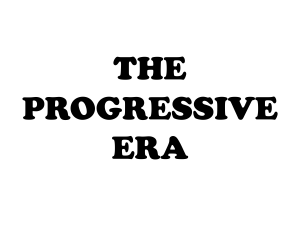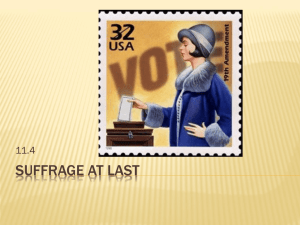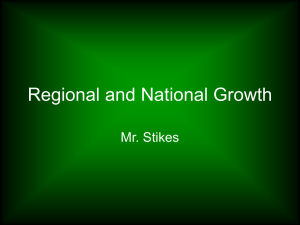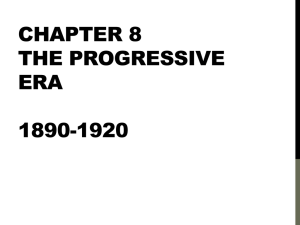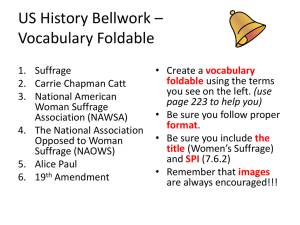The Road to Suffrage - Maxwell School
advertisement
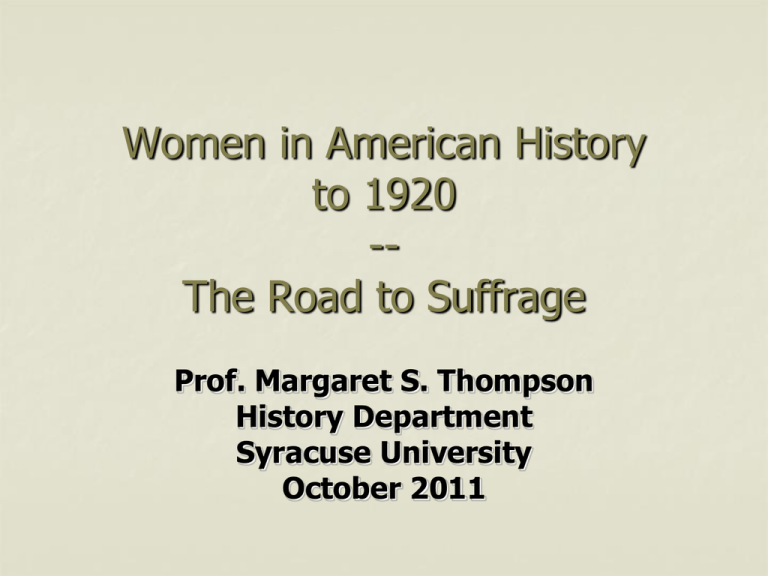
Women in American History to 1920 -The Road to Suffrage Prof. Margaret S. Thompson History Department Syracuse University October 2011 Women’s Suffrage Precedents Lydia Chapin Taft, Uxbridge, MA—voted in 3 Town Meetings as early as 1756 In New Jersey, women owning more than $250 in property could vote, 17901807. June 1848, Gerrit Smith of Utica made women’s suffrage a plank in the Liberty Party platform. Abigail Adams (1744-1818) “… remember the ladies, and be more generous and favorable to them than your ancestors. Do not put such unlimited power into the hands of the Husbands. Remember all Men would be tyrants if they could. If particular care and attention is not paid to the Ladies we are determined to foment a Rebellion, and will not hold ourselves bound by any Laws in which we have no voice, or Representation.” [letter to John Adams, March 1776] “Republican Motherhood” Children should be raised to uphold the ideals of republicanism, making them ideal citizens of the new nation. Elevated the role of women in raising the next generation. Contributed to support for educational opportunities for girls and women as “future mothers” in the Early Republic. Not unrelatedly, Susan B. Anthony’s second known instance of public activism was in 1837, calling for equal pay for women teachers. She was only 17, and a new teacher herself. [Her first significant political action was at the age of 16, when she collected 2 boxes of antislavery petitions.] [Susan B. Anthony in her 20s.] Women as Social/Political Reformers [prior to women’s rights activism] Temperance Education [Indeed, in 1837, Kentucky gave some women property owners the right to vote in school board elections.] Abolitionism Women Speakers at “promiscuous assemblies.” Property Rights—leading to the New York Married Women’s Property Rights Act of 1848. Early women’s rights activists [many prior to 1848] Lucretia Mott Margaret Fuller Frances Wright Martha Coffin Wright (sister of L. Mott) Abby Kelley Sophia Ripley Sarah and Angelina Grimke Ernestine Rose Harriet Tubman Male allies: Frederick Douglass, Gerrit Smith, William Lloyd Garrison, Henry Blackwell. In 1840, a young Elizabeth Cady Stanton attended the International AntiSlavery Convention in London on her honeymoon. There, she met numerous abolitionists, including William Lloyd Garrison and Lucretia Mott. Mott was a delegate to the Convention (as was Henry Stanton), but it refused to seat her because she was a woman. In protest, Garrison sat with the women in the balcony, where ECS and Mott held their first known conversation about women’s rights. Seneca Falls Women’s Rights Convention, 19-20 July 1848 3 main organizers: Stanton, Mott, Martha Wright (Declaration of Sentiments written at Wright’s home in Auburn). c. 300 in attendance, 100 of whom signed, 1/3 of them men. The suffrage resolution was a last-minute addition, not originally a central component. Only one signer (Charlotte Woodward, 19 in 1848) was alive to vote in 1920, after ratification of the Nineteenth Amendment. American Equal Rights Assn. Founded in 1866 from the American AntiSlavery Society—would disintegrate by 1869. Initially aimed at uniting the causes of racial and women’s equality. Initially, debate over whether or not to support 14th Amendment (1868) and, even moreso, the 15th. WHY WOULD THESE BE AN ISSUE? NWSA & AWSA founded from splinters in 1869. Constitutional Amendment Controversies State Referenda on Black and Women’s Suffrage—first in Kansas (1867). Both lost, but women’s suffrage by larger margin. What were the issues with 14th and 15th Amendments? The controversy itself was a sign of progress. “Take your turn, ladies”: F. Douglass, etc. Three More Controversies of 1872 The peculiar story of George Francis Train. Victoria Woodhull ran for president on the “Equal Rights Party” ticket. November: Susan B. Anthony arrested and tried (in Canandaigua) for attempting to vote in the Presidential election. Found guilty; never paid fine. George Francis Train Victoria Woodhull National Women’s Suffrage Assn. Opposed Fifteenth Amendment. More inclusive women’s rights agenda. Members included: Eliz. Cady Stanton, Susan B. Anthony, Matilda Joslyn Gage, Martha Wright Coffin, Lucretia Mott, Ernestine Rose, etc. American Women’s Suffrage Assn. Supported Fifteenth Amendment. “Suffrage only” agenda. Members included: Lucy Stone, Julia Ward Howe, Blanche Ames, Josephine Ruffin, Frederick Douglass. National American Women’s Suffrage Association (1890). NWSA/AWSA merged to form new organization, basically with the agenda of the old AWSA. Among new leaders were Frances Willard, Anna Shaw, Mary Church Terrell, and Carrie Chapman Catt. 1868: First women’s suffrage amendment introduced in US House; in 1878 in Senate (called the “Anthony Amendment”). 1869: Wyoming Territory grants full voting rights to women; Utah does so in 1870, and Washington Territory in 1883. 1872: GOP Platform includes reference to women’s suffrage for the first time. 1878: Senate hearing on the Anthony Amendment. 1887: Senate votes on women’s suffrage for the first time (and the last for the next 25 years); it is defeated. STATEHOOD Suffrage: Wyoming (1890), Colorado (1893), Utah (1896), Washington (1910), California (1911), Oregon, Kansas, Arizona (1912), Illinois (1913—first state east of Mississippi River). Expanding Suffrage’s Constituency Frances Willard and the WCTU. African-American women: welcome, or not? [NACW and Mary M. Bethune] Suffrage and the Clubwoman movement. “Social Housekeeping” As Jane Addams put it: “Politics is housekeeping on a grand scale.” Stressed the nurturing and redemptive qualities of motherhood and social justice. Women should vote not because they were human Beings like men—but precisely because they were different and “feminine.” The Final Push Toward Suffrage Federal Amendment or State-by-State Approach? Suffrage only, or broader “women’s” agenda? Radical or mainstream tactics? Feminism: are women the same as (sharing common “human” identities) or distinct from men? Do they deserve suffrage in spite or, or because of, their similarities or differences? The central role and strategic sophistication of Carrie Chapman Catt. 3 March 1913—Suffrage March on Washington. Timed for the day before Woodrow Wilson’s inaugural (and upstaged it). More than 5000 marchers, including delegations from nations that had already enfranchised women. Women wore white (became the “official” color of the suffrage movement, and continued with the Equal Rights movement in the later part of the century). Racially segregated, so as not to “offend” Southern white women, or President-elect Wilson. Not all Black women went along with this. Alice Paul Founded the Congressional Union in 1913, initially within NAWSA. 1914: Split with NAWSA and, in 1916, became the National Women’s Party. By 1916, NWP picketing the White House and performing acts of civil disobedience. Introduces the Equal Rights Amendment in 1923. Jeannette Rankin (1880-1973) Becomes first woman (R-MT) elected to Congress in 1916. Elected again in 1940, she voted against US entry into both World War I and World War II. Founding member (1915) of the Women’s International League for Peace & Freedom, and founding VP of the ACLU. The Campaign’s Last Stages The “Great War” and support for women’s suffrage. January 1918: President Wilson declares need for women’s suffrage as a “war measure.” January 1919 Ratification of the Eighteenth Amendment. 21 May 1919: House passes “Anthony Amendment. 4 June: Senate passes it, too. 36 States needed for ratification; the last was Tennessee. [The story of Harry Burns.] Suffrage finally passed in Tennessee by one vote, and the “Anthony Amendment” ratified, 18 August 1920. The meaning of suffrage—what was accomplished, and not? By the time it was achieved, was women’s suffrage a feminist accomplishment? Was there then—and has there ever been—a “women’s vote”? What about the larger agenda of Seneca Falls, and of “First-Wave” feminism? Did suffragists compromise too much to achieve the objective of the vote alone?
